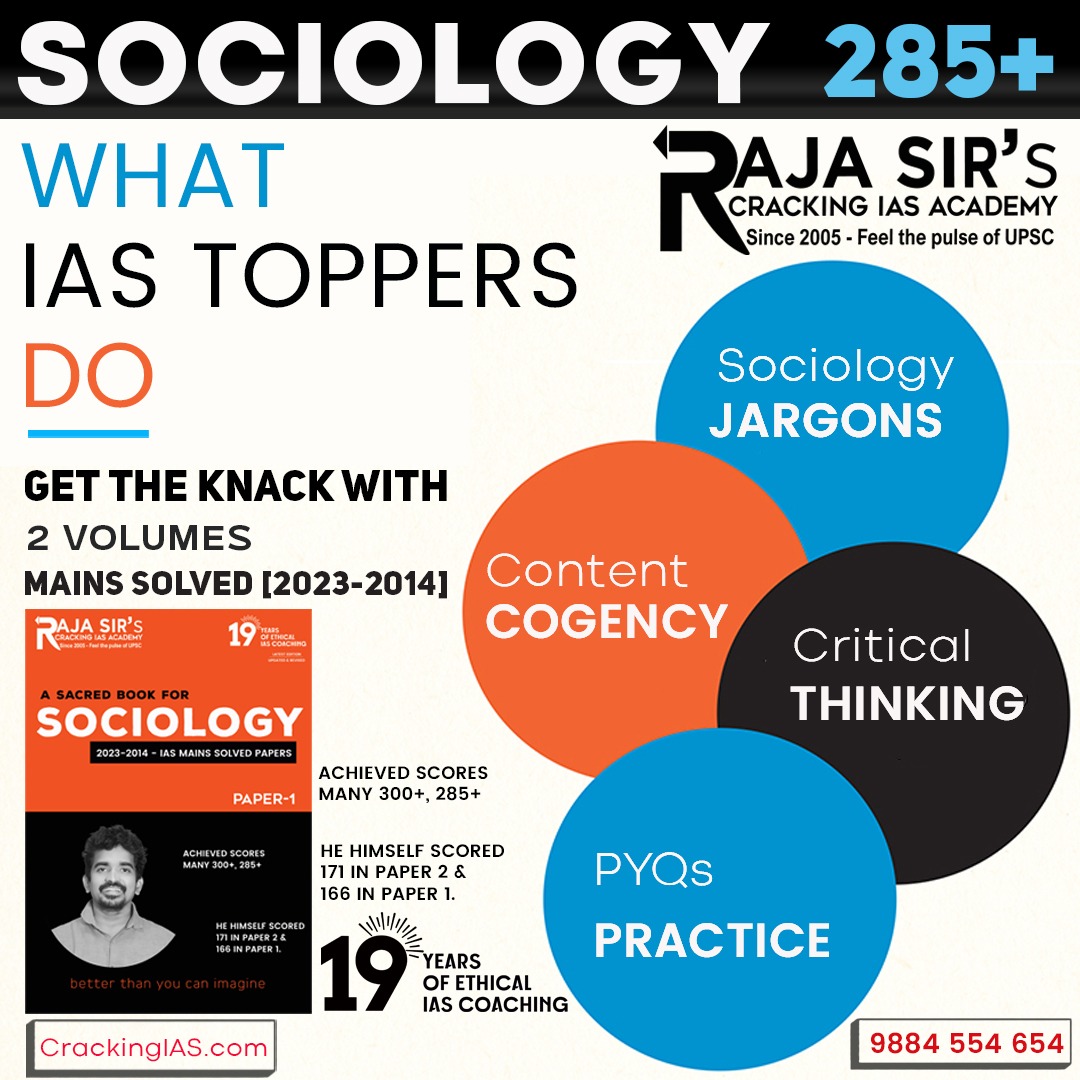- Home
- Prelims
- Mains
- Current Affairs
- Study Materials
- Test Series
 EDITORIALS & ARTICLES
EDITORIALS & ARTICLES
Hit List Questions 78 -PPP 100 PRELIMS 2024 - 96
Questions & Explanations:
|
1. |
Which of the following statement is/are correct?. (a) The Himalayan Wolf has been categorised as ‘Vulnerable’ on the IUCN Red List. (b) Wolf is monogamous. (c) Wolves exhibit a behavior called scent–marking. (d) All the above
|
||||||||||
|
2. |
Consider the following statements w.r.t. Prosopis juliflora. 1. It is a phreatophyte. 2. It produces less oxygen and more carbon dioxide. (a) Only 1 is true (b) Only 2 is true (c) Both 1 and 2 are true (d) Neither 1 nor 2 is true
|
||||||||||
|
3. |
Which of the following is/are true w.r.t. Cystic Fibrosis? 1. It is an inherited condition. 2. It causes sticky mucus to build up in the lungs. (a) 1 only (b) 2 only (c) Both 1 and 2 (d) Neither 1 nor 2
|
||||||||||
|
4. |
Consider the following statements. 1. Tapeworm is a hermaphrodite. 2. Round-worm has separate sexes. 3. Filaria is caused by a nematode. 4. Guinea-worm is an annelid. Which of these are correct? (a) 1 and 2 (b) 1, 2 and 3 (c) 3 and 4 (d) 2, 3 and 4
|
||||||||||
|
5. |
Which of the following is/are true w.r.t. Conserved genes? 1. They are are genes that natural selection has not changed. 2. They don’t encode proteins. (a) 1 only (b) 2 only (c) Both 1 and 2 (d) Neither 1 nor 2 |
||||||||||
|
6. |
1. It is caused by prion. 2. It affects cattle. Which of the above statements is/are correct w.r.t. Ranikhet disease? (a) 1 only (b) 2 only (c) Both 1 and 2 (d) Neither 1 nor 2
|
||||||||||
|
7. |
Identify the incorrect pair. (a) Stem climber - Clitoria (b) Root climber – Pisum (c) Thorn climber - Bougainvilea (d) Tendril climber – Nepenthes
|
||||||||||
|
8. |
Chondrocytes are found in (a) Sperm (b) Ova (c) Cartillage (d) Ear wall
|
||||||||||
|
9. |
Th(is)ese (is)are symbiotic nitrogen fixation systems. 1. Bryophytes 2. Legumes 3. Gymnosperms (a) Only 2 (b) 1 & 3 (c) 1 & 2 (d) 1, 2 & 3
|
||||||||||
|
10. |
Consider the following statements regarding inositol: 1. It is a lipid. 2. It is abundant in the brain. 3. It is necessary for the formation of cell membranes in our body. 4. It is primarily synthesised in the kidney. (a) 1, 2. 3 (b) 1, 3. 4 (c) 2, 3. 4 (d) 1, 2. 4
|
||||||||||
|
11. |
What is “brumation”?. (a) a chemical evolutionary stage (b) an arctic condensation (c) a biological evolutionary stage (d) None of these
|
||||||||||
|
12. |
Sea-whip is a/an (a) Mammal (b) Fish (c) Echinodermate (d) Cnidarian
|
||||||||||
|
13. |
Match List-I with List-II and select the correct answer using the codes given below/the lists:
A B C D (a) 3 4 1 2 (b) 4 3 1 2 (c) 4 3 2 1 (d) 3 4 2 1
|
||||||||||
|
14. |
1. Embryonic stem cells are pluripotent. 2. Induced pluripotent stem cells are derived from Embryonic stem cells. (a) Only 1 is true. (b) Only 2 is true. (c) 1 & 2 are true (d) Neither 1 nor 2 is true
|
||||||||||
|
15. |
I. Reference genome is a linear sequence while the Pangenome is a graph. II. Each chromosome in the pangenome can be imagined as a bamboo stem with nodes. Which of the above statements is/are true?. (a) Only I (b) Only II (c) Both I & II (d) Neither I nor II
|
||||||||||
|
16. |
1. Baleen whales are generally larger than toothed whales except for the sperm whale which is very big and has teeth. 2. The baleen plates in the mouths of baleen whales are primarily composed of bone material. (a) Only (1) is true (b) Only (2) is true (c) Both (1) & (2) are true (d) Neither (1) Nor (2) is true
|
||||||||||
|
17. |
Hybridoma technology is used for commercial production of (a) Monoclonal antibodies (b) m RNA Vaccines (c) DNA Vaccines (d) Induced stem cells
|
||||||||||
|
18. |
Small mammals and birds are rarely found in polar regions. The reason is that (a) They have a larger surface area relative to their volume (b) They tend to gain heat very fast (c) They expend less energy to generate body heat (d) None of these
|
||||||||||
|
19. |
Somatic cell nuclear transfer produces a/an (a) hybrid (b) clone (c) protoplast fuse (d) crossing over
|
||||||||||
|
20. |
GTR genes seen in news are found in (a) Rubber (b) Cotton (c) Brinjal (d) Mustard
|
||||||||||
|
21. |
1. In response to the presence of HCl, secretin is produced from the duodenum. 2. Enterogastrone is produced in the small intestine in response to the presence of fatty acids. Which of these statements is/are correct w.r.t. normal human beings? (a) Only 1 (b) Only 2 (c) Both 1 and 2 (d) Neither 1 nor 2
|
||||||||||
|
22. |
Identify the correct statement(s). 1. Every chromosome contains one long DNA molecule plus several chromosomal proteins. 2. When a gene is expressed, it means the sequence is copied onto the sequence of bases in a related molecule, called RNA. (a) 1 only (b) 2 only (c) Both 1 and 2 (d) Neither 1 nor 2
|
||||||||||
|
23. |
1. Asexual reproduction involves formation of clones of an organism. 2. Clones are morphologically and genetically similar individuals. Which of the statements given above is/are correct? (a) Only 1 (b) Only 2 (c) Both 1 and 2 (d) Neither 1 nor 2
|
||||||||||
|
24. |
Marine cloud brightening would produce (a) drought (b) cooling effect (c) decrease rain to control floods (d) Both (b) and (c)
|
||||||||||
|
25. |
1. Elephants’s brain is the biggest in the animal kingdom. 2. Sea Anemones have the smallest brain in the animal kingdom. Which of the above statements is/are false?. (a) Only 1 (b) Only 2 (c) Both 1 and 2 (d) Neither 1 nor 2
|
EXPLANATIONS
|
1. |
Wolves mark their territories with urine and scats, a behavior called scent–marking. Both tigers and wolves are classified under “Schedule I” of the Wildlife Protection Act. |
D |
|
2. |
· A phreatophyte is a deep-rooted plant that acquires a significant portion of the water that it requires from the phreatic zone (i.e. the zone of saturation) or the capillary fringe right above the phreatic zone. Phreatophytes are those plants that are supplied with surface water and often have their roots continuously in touch with the moisture. · A phreatophyte is that plant that absorbs its water from a continuous source on the ground. They can usually get located along streams where there is a uniform flow of surface or groundwater in areas where the water table is closer to the surface. These plants are adapted to grow in the arid environments. · Phreatophytes live in areas of standing or running water, in arid areas and along the riverbeds and areas, apparently dry, where the water table is very shallow and near the surface. These plants have very deep roots that are able to reach to the water table. Phreatophytes are not only the characteristic of arid or in desert zones, but also of wetlands, depressions, floodplains that hold water and estuaries. Prosopis juliflora:
Impacts on Environment
|
C |
|
3. |
C |
|
|
4. |
Tape worms are hermaphrodite both male and female reproductive organ present. Round worms are unisexual separate sex. Filaria is caused by Wuchereria bancrofti which is a parasitic nematode. Guinea worm is a long and very thin nematode not an annelid. |
B |
|
5. |
C |
|
|
6. |
· Ranikhet is a Viral disease. · This disease is also called New Castle Disease or Doyle’s disease. · This is an acute viral disease of poultry characterized by involvement of the respiratory system, drop in egg production and death in severe cases. · The host includes chicken, turkey, guinea fowls, ducks, doves, geese, pigeons, pheasants, crows, sparrows, and other free-flying birds. · This virus has a zoonotic effect and can cause harm to human health. · Exposure of humans to infected birds (for example in poultry processing plants) can cause mild conjunctivitis and influenza-like symptoms, but the Newcastle disease virus (NDV) otherwise poses no hazard to human health. · Chicks are highly susceptible; adults are less susceptible. · It is caused by Paramyxovirus type1 (PMV-1 belongs to the genus Avulavirus, family Paramyxoviridae). · Various physical (heat, irradiation and pH effects) and chemical compounds (potassium permanganate, formalin, ethanol, etc.) can destroy the virus. · The disease can be prevented effectively by an integrated approach of vaccination, proper management and strict biosecurity. · Newcastle disease was first identified in Java, Indonesia, in 1926. |
D |
|
7. |
Climbers These plants have long weak stem and produce special organs for attachment for climbing over a support. Climbing helps to display the leaves towards sunlight and to position the flower for effective pollination. i. Root climbers Plants climbing with the help of adventitious roots (arise from nodes) as in species of Piper betel, Piper nigrum, Hedera helix, Pothos, Hoya. ii. Stem climbers (twiners) These climbers lack specialised structure for climbing and the stem itself coils around the support. Example: Ipomoea, Convolvulus, Dolichos, Clitoria, Quisqualis. Stem climbers may coil around the support clockwise or anti-clockwise. Clockwise coiling climbers are called dextrose. Example: Dioscorea alata. Anti-clockwise coiling climbers are called sinistrose. Example: Dioscorea bulbifera. iii. Hook climbers These plants produce specialized hook like structures which are the modification of various organs of the plant. In Artabotrys inflorescence axis is modified into hook. In calamus (curved hook) leaf tip is modified into hook. In Bignonia unguis- cati the leaflets are modified into curved hook. In Hugonia the axillary buds modified into hook. iv. Thorn climbers Climbing or reclining on the support with the help of thorns as in Bougainvillea and Carissa. v. Lianas (woody stem climber) Woody perennial climbers found in tropical forests are lianas. They twine themselves around tall trees to get light. Example: Hiptage benghalensis, Bauhinia vahlii, Entada pursaetha. vi. Tendril climbers Tendrils are thread-like coiling structures which help the plants in climbing. Tendrils may be modifications of Stem – as in Passiflora, Vitis and Cissus quadrangularis; Inflorescence axis – Antigonon; Leaf – Lathyrus; Leaflets - Pisum sativum; Petiole – Clematis; Leaftip – Gloriosa; Stipules – Smilax. In pitcher plant (Nepenthes) the midrib of the leaf often coils around a support like a tendril and holds the pitcher in a vertical position. |
B |
|
8. |
C |
|
|
9. |
Ø There are many symbiotic nitrogen fixation systems such as Lichens, Pteridophytes, Bryophytes, Gymnosperms and Legumes. Ø Cyanobacteria are the symbiotic component in Lichens, Bryophytes, Pteridophytes and Gymnosperms. In Legumes, the symbiont is a species of bacterium Rhizobium. |
D |
|
10. |
It is a sugar. https://www.thehindu.com/sci-tech/science/richness-of-human-milk/article67334716.ece
|
C |
|
11. |
https://www.thehindu.com/sci-tech/science/estivation-the-summers-urge-to-nap/article67423446.ece |
D |
|
12. |
https://indianexpress.com/article/technology/science/microbe-saving-coral-climate-change-9111960/ Sea-Whip is a species of soft coral. |
D |
|
13. |
According to Hugo De Vries, new species are not formed by continuous variations but by the sudden appearance of variations, which he named as mutations. He also met some of the objections found in Darwin’s theory. In biology, a mutation is a permanent change to the genetic material in an organism, virus, or other genetic elements. These changes are caused by damage to DNA or RNA, errors while copying the genetic material, or by the insertion or removal of pieces of the genetic material. Mutations play a role in both normal and abnormal biological processes, like evolution, cancer, and the development of the immune system. They are also the main factor in the emergence of new species. Darwinism is a theory of biological evolution developed by the English naturalist Charles Darwin and others, stating that all species of organisms arise and develop through the natural selection of small, inherited variations that increase the individual''s ability to compete, survive, and reproduce. The George Beadle and Edward Tatum experiment proved that genes are responsible for making enzymes that control metabolic processes. From there, they determined that the mold needed the amino acid arginine, and their mutation was to a single gene that could encode for the enzyme that could produce it. Operon Theory is the concept of gene regulation proposed by François Jacob and Jacques Monod. An operon is a group of structural genes whose expression is coordinated by an operator. The repressor encoded by a regulatory gene binds to the operator and represses the transcription of operon. |
D |
|
14. |
A |
|
|
15. |
C |
|
|
16. |
The baleen plates in the mouths of baleen whales are not composed of bone material; instead, they are made of keratin, the same protein found in human hair and nails. Baleen plates are comb-like structures that baleen whales use to filter small prey, such as krill, from the water during feeding. Baleen Whales · There are 14 species of baleen whale including the blue, bowhead, right, humpback, minke and gray whale. · Baleen whales are generally larger than toothed whales except for the sperm whale which is very big and has teeth. · Many baleen whales migrate annually, travelling long distances between cold water feeding areas and warm water breeding areas. Feeding Technique · Baleen whale, any cetacean possessing unique epidermal modifications of the mouth called baleen, which is used to filter food from water. · Baleen whales seek out concentrations of small planktonic animals. · The whales then open their mouth and take in enormous quantities of water. · When the mouth is closed, they squeeze the water out through the sides, catching the tiny prey on the baleen’s bristles. Special Structure Baleen · Baleen is a keratinized structure like hair, fingernails, and hooves. · In the Greenland right whale (Balaena mysticetus), single plates of baleen can reach 5.2 meters (17 feet) long. · Before the invention of spring steel and celluloid in the 19th century, “whalebone,” as baleen was called, was very valuable. · Because it is flexible and retains shapes imposed on it with heat, baleen was used for springs and in products such as corsets, knife handles, umbrella ribs, brushes, and fans. Songs · The large air-breathing sea animals use a special voice box that enables them to make sounds underwater. · Baleen whales do not have teeth or vocal cords like humans and other mammals. · They have U-shaped tissue in their voice boxes that permits them to breathe a lot of air very quickly. · Their voice boxes also contain a large “cushion” of fat and muscle not seen in other animals. · Whales “sing” by pushing the tissue against the fat and muscle cushion. · Baleen whales depend on the production of sound to communicate in the dark of the deep oceans. · “For example, humpback females and their calves communicate with each other by voice, and humpback males sing to attract females, Distribution · Baleen whales can be found in all oceans worldwide, from polar seas to temperate and tropical zones. Some species of baleen whales have limited distribution. For example: · Southern right whales are found only in the southern hemisphere; northern right whales are found only in the northern hemisphere. · Some populations of baleen whale species are resident to restricted areas. A population of fin whales (Balaenoptera physalus) is found year-round in the Gulf of California Habitat · Some baleen whales are coastal (they stay near shore). · They forage along the productive continental shelf area. · Some species give birth and rear young in protected coastal bays and lagoons. Other species are oceanic (they roam the open seas). Migration · Most baleen whales are highly migratory, moving toward high-latitude (polar) feeding areas in the summer and toward low-latitude (tropical) calving areas in the winter. · Variations in water temperature, food availability, and feeding habits may account for the movements of some animals. · Some individual whales do not migrate. These may be juveniles or post-reproductive adults and may stay in protected nearshore areas. |
A |
|
17. |
Hybridoma technology involves fusing short-lived antibody-producing B cells with immortal myeloma cells, creating cell lines that produce a never-ending supply of a specific monoclonal antibody. The technique was created in 1975 by Nobel prize-winning scientists Georges Kohler and Cesar Milstein. |
A |
|
18. |
Thermoreguation is an energetically expensive process for many organisms. Heat loss or gain is a function of surface area. Small sized animals (such as shrews, humming birds etc.) have a larger surface area relative to their volume, they tend to lose body heat very fast when it is cold outside, thus they have to expend much energy o generate body heat thorough metabolism. This is the main reason why very small animals are rarely found in polar regions.
|
A |
|
19. |
https://www.thehindu.com/sci-tech/sci-five-the-hindu-science-quiz-on-cloning/article67326084.ece Hybridization is a method of sexual reproduction whereas cloning is a method of asexual reproduction. Hybrids animals are sterile, but cloned animals are fertile. Hybrid organism contains DNA from male and female parents, but cloned organism contains DNA from only one type of parent. Protoplast fusion: The protoplasm of the living plant cell excluding the cell wall is called protoplast. Fusion of the protoplast derived from somatic cells of plants belonging to different species produces a hybrid protoplast, this process is called protoplast fusion. Fusion of protoplasts can be obtained - Either chemically with the help of a mixture of polyethylene glycol (PEG) and a high concentration of calcium at pH 8. Or physically by electrofusion. The pomato is a transgenic crop produced by protoplast fusion of a tomato plant and a potato plant. Crossing over is a cellular process that happens during meiosis when chromosomes of the same type are lined up. When two chromosomes — one from the mother and one from the father — line up, parts of the chromosome can be switched. The two chromosomes contain the same genes, but may have different forms of the genes. Somatic cell nuclear transfer (SCNT) technology is a technique that involves transferring the nucleus of a somatic cell into an enucleated egg cell. This process results in the formation of a cloned embryo, which can be implanted into a surrogate mother for gestation. Application of SCNT Technology The main application of SCNT technology is in the field of reproductive cloning of animals. This technology has been used to produce clones of a wide range of animals, including sheep, cows, pigs, cats, dogs, and even a horse. The first cloned animal, Dolly the sheep, was produced using SCNT technology. Advantages of SCNT Technology 1. Preservation of Endangered Species: SCNT technology can be used to preserve endangered animal species by producing clones of animals that are at risk of extinction. 2. Production of Transgenic Animals: SCNT technology can be used to produce transgenic animals that have been genetically engineered to express specific traits or proteins. This can be useful in the production of pharmaceuticals or in the study of genetic diseases. 3. Improvement of Livestock: SCNT technology can be used to produce clones of high-quality breeding stock, which can be used to improve the quality of livestock. Limitations of SCNT Technology 1. Low Efficiency: The success rate of SCNT technology is relatively low, with only a small percentage of cloned embryos developing into viable offspring. 2. Ethical Concerns: There are ethical concerns surrounding the use of SCNT technology, particularly in the production of cloned humans. Many people argue that cloning humans is unethical and should not be allowed. |
B |
|
20. |
D |
|
|
21. |
• HCl is secreted, providing an acid medium for pepsin action and kill most bacteria and helps in digestion of food. When the food enters in duodenum (small intestine), secretin is produced by intestine that stimulates pancreas for pancreatic juice secretion. • Enterogastrone is produced in small intestine. |
C |
|
22. |
C |
|
|
23. |
When an offspring is produced by a single parent without the involvement of gamete formation, the reproduction is called asexual reproduction. As a result, the offspring produced are not only similar to one another but are also exact copies of their parent. Such a group of morphologically and genetically similar individuals are called clones. A clone is a genetically similar organism to its parent organism. This means the genetic character of the parent and the offspring is the same. This mainly occurs through asexual reproduction as in sexual reproduction there are changes in the genetic material. This is because meiosis occurs in sexual reproduction and that is why genetic changes are expected there, whereas mitosis occurs in asexual reproduction from a single parent which results in the same genetic character. This is why at the end of the process; the offspring will have genetically similar offspring. These offspring are called clones due to this character. Genetically dissimilar organisms are produced through sexual reproduction due to the fusion of gametes and meiosis, but they are not clones. |
C |
|
24. |
First proposed by American climatologist John Latham, seawater is sprayed into the atmosphere, allowing water vapor to condense upon the salt particles and formulate clouds with higher albedo. These clouds have greater ability to reflect incoming solar radiation, which can then cool surface temperatures. |
B |
|
25. |
Sperm whale’s brain is the biggest in the animal kingdom. Sea Anemones do not have the brain. |
C |









 Latest News
Latest News




 General Studies
General Studies